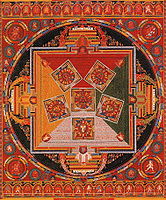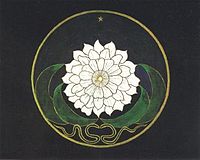Mandala

Multi tool use

Thangka painting of Manjuvajra mandala
A mandala (emphasis on first syllable; Sanskrit मण्डल, maṇḍala – literally "circle") is a spiritual and ritual symbol in the Indian religions of Hinduism and Buddhism, representing the universe.[1] In common use, "mandala" has become a generic term for any diagram, chart or geometric pattern that represents the cosmos metaphysically or symbolically; a microcosm of the universe.
The basic form of most mandalas is a square with four gates containing a circle with a center point. Each gate is in the general shape of a T.[2] Mandalas often have radial balance.[3]
The term appears in the Rigveda as the name of the sections of the work, and Vedic rituals use mandalas such as the Navagraha mandala to this day. Mandalas are also used in Buddhism.
In various spiritual traditions, mandalas may be employed for focusing attention of practitioners and adepts, as a spiritual guidance tool, for establishing a sacred space and as an aid to meditation and trance induction.
Contents
1 Hinduism
1.1 Religious meaning
1.2 Political meaning
2 Buddhism
2.1 Vajrayana
2.1.1 Visualisation of Vajrayana teachings
2.1.1.1 Mount Meru
2.1.1.2 Wisdom and impermanence
2.1.1.3 Five Buddhas
2.1.2 Practice
2.1.3 Offerings
2.2 Shingon Buddhism
2.3 Nichiren Buddhism
2.4 Pure Land Buddhism
3 Mesoamerican civilizations
3.1 Mayan Tzolk'in
3.2 Aztec Sun Stone
4 Christianity
5 Mandalas in Persian art
6 Western psychological interpretations
7 In archaeology
8 In architecture
9 In science
10 In contemporary use
11 Gallery
12 See also
13 References
14 Sources
15 Further reading
16 External links
Hinduism
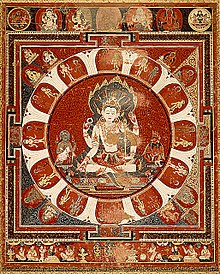
Mandala of Vishnu
Religious meaning
A yantra is similar to a mandala, usually smaller and using a more limited colour palette. It may be a two- or three-dimensional geometric composition used in sadhanas, puja or meditative rituals, and may incorporate a mantra into its design. It is considered to represent the abode of the deity. Each yantra is unique and calls the deity into the presence of the practitioner through the elaborate symbolic geometric designs. According to one scholar, "Yantras function as revelatory symbols of cosmic truths and as instructional charts of the spiritual aspect of human experience"[4]
Many situate yantras as central focus points for Hindu tantric practice. Yantras are not representations, but are lived, experiential, nondual realities. As Khanna describes:
Despite its cosmic meanings a yantra is a reality lived. Because of the relationship that exists in the Tantras between the outer world (the macrocosm) and man's inner world (the microcosm), every symbol in a yantra is ambivalently resonant in inner–outer synthesis, and is associated with the subtle body and aspects of human consciousness.[5]
Political meaning
The Rajamandala (or Raja-mandala; circle of states) was formulated by the Indian author Kautilya in his work on politics, the Arthashastra (written between 4th century BCE and 2nd century BCE). It describes circles of friendly and enemy states surrounding the king's state.[6]
In historical, social and political sense, the term "mandala" is also employed to denote traditional Southeast Asian political formations (such as federation of kingdoms or vassalized states). It was adopted by 20th century Western historians from ancient Indian political discourse as a means of avoiding the term 'state' in the conventional sense. Not only did Southeast Asian polities not conform to Chinese and European views of a territorially defined state with fixed borders and a bureaucratic apparatus, but they diverged considerably in the opposite direction: the polity was defined by its centre rather than its boundaries, and it could be composed of numerous other tributary polities without undergoing administrative integration.[7] Empires such as Bagan, Ayutthaya, Champa, Khmer, Srivijaya and Majapahit are known as "mandala" in this sense.
Buddhism

Painted 17th-century Tibetan 'Five Deity Mandala', in the centre is Rakta Yamari (the Red Enemy of Death) embracing his consort Vajra Vetali, in the corners are the Red, Green White and Yellow Yamaris, Rubin Museum of Art

Sandpainting showing Buddha mandala, which is made as part of the death rituals among Buddhist Newars of Nepal
Vajrayana
In Vajrayana Buddhism, mandalas have been developed also into sandpainting. They are also a key part of Anuttarayoga Tantra meditation practices.
Visualisation of Vajrayana teachings
The mandala can be shown to represent in visual form the core essence of the Vajrayana teachings. The mind is "a microcosm representing various divine powers at work in the universe."[8] The mandala represents the nature of the Pure Land, Enlightened mind.
An example of this type of mandala is Vajrabhairava mandala a silk tapestry woven with gilded paper depicting lavish elements like crowns and jewelry, which gives a three-dimensional effect to the piece.[9][10]
Mount Meru
A mandala can also represent the entire universe, which is traditionally depicted with Mount Meru as the axis mundi in the center, surrounded by the continents.[11] One example is the Cosmological Mandala with Mount Meru, a silk tapestry from the Yuan dynasty that serves as a diagram of the Tibetan cosmology, which was given to China from Nepal and Tibet.[12][13]
Wisdom and impermanence
In the mandala, the outer circle of fire usually symbolises wisdom. The ring of eight charnel grounds[14] represents the Buddhist exhortation to be always mindful of death, and the impermanence with which samsara is suffused: "such locations were utilized in order to confront and to realize the transient nature of life".[15] Described elsewhere: "within a flaming rainbow nimbus and encircled by a black ring of dorjes, the major outer ring depicts the eight great charnel grounds, to emphasize the dangerous nature of human life".[16] Inside these rings lie the walls of the mandala palace itself, specifically a place populated by deities and Buddhas.
Five Buddhas
One well-known type of mandala is the mandala of the "Five Buddhas", archetypal Buddha forms embodying various aspects of enlightenment. Such Buddhas are depicted depending on the school of Buddhism, and even the specific purpose of the mandala. A common mandala of this type is that of the Five Wisdom Buddhas (a.k.a. Five Jinas), the Buddhas Vairocana, Aksobhya, Ratnasambhava, Amitabha and Amoghasiddhi. When paired with another mandala depicting the Five Wisdom Kings, this forms the Mandala of the Two Realms.
Practice

Tantric mandala of Vajrayogini
Mandalas are commonly used by tantric Buddhists as an aid to meditation.
The mandala is "a support for the meditating person",[17] something to be repeatedly contemplated to the point of saturation, such that the image of the mandala becomes fully internalised in even the minutest detail and can then be summoned and contemplated at will as a clear and vivid visualized image. With every mandala comes what Tucci calls "its associated liturgy ... contained in texts known as tantras",[18] instructing practitioners on how the mandala should be drawn, built and visualised, and indicating the mantras to be recited during its ritual use.
By visualizing "pure lands", one learns to understand experience itself as pure, and as the abode of enlightenment. The protection that we need, in this view, is from our own minds, as much as from external sources of confusion. In many tantric mandalas, this aspect of separation and protection from the outer samsaric world is depicted by "the four outer circles: the purifying fire of wisdom, the vajra circle, the circle with the eight tombs, the lotus circle".[17] The ring of vajras forms a connected fence-like arrangement running around the perimeter of the outer mandala circle.[19]
As a meditation on impermanence (a central teaching of Buddhism), after days or weeks of creating the intricate pattern of a sand mandala, the sand is brushed together into a pile and spilled into a body of running water to spread the blessings of the mandala.
Kværne[20] in his extended discussion of sahaja, discusses the relationship of sadhana interiority and exteriority in relation to mandala thus:
.mw-parser-output .templatequote{overflow:hidden;margin:1em 0;padding:0 40px}.mw-parser-output .templatequote .templatequotecite{line-height:1.5em;text-align:left;padding-left:1.6em;margin-top:0}
...external ritual and internal sadhana form an indistinguishable whole, and this unity finds its most pregnant expression in the form of the mandala, the sacred enclosure consisting of concentric squares and circles drawn on the ground and representing that adamant plane of being on which the aspirant to Buddha hood wishes to establish himself. The unfolding of the tantric ritual depends on the mandala; and where a material mandala is not employed, the adept proceeds to construct one mentally in the course of his meditation."[21]
Offerings

Chenrezig sand mandala created at the House of Commons of the United Kingdom on the occasion of the Dalai Lama's visit in May 2008
A "mandala offering"[22] in Tibetan Buddhism is a symbolic offering of the entire universe. Every intricate detail of these mandalas is fixed in the tradition and has specific symbolic meanings, often on more than one level.
Whereas the above mandala represents the pure surroundings of a Buddha, this mandala represents the universe. This type of mandala is used for the mandala-offerings, during which one symbolically offers the universe to the Buddhas or to one's teacher. Within Vajrayana practice, 1,000,000 of these mandala offerings (to create merit) can be part of the preliminary practices before a student even begins actual tantric practices.[23] This mandala is generally structured according to the model of the universe as taught in a Buddhist classic text the Abhidharma-kośa, with Mount Meru at the centre, surrounded by the continents, oceans and mountains, etc.
Shingon Buddhism
One Japanese branch of Mahayana Buddhism—Shingon Buddhism—makes frequent use of mandalas in its rituals as well, though the actual mandalas differ. When Shingon's founder, Kukai, returned from his training in China, he brought back two mandalas that became central to Shingon ritual: the Mandala of the Womb Realm and the Mandala of the Diamond Realm.
These two mandalas are engaged in the abhiseka initiation rituals for new Shingon students, more commonly known as the Kechien Kanjō (結縁灌頂). A common feature of this ritual is to blindfold the new initiate and to have them throw a flower upon either mandala. Where the flower lands assists in the determination of which tutelary deity the initiate should follow.
Sand mandalas, as found in Tibetan Buddhism, are not practiced in Shingon Buddhism.
Nichiren Buddhism
The mandala in Nichiren Buddhism is called a moji-mandala (文字曼陀羅) and is a paper hanging scroll or wooden tablet whose inscription consists of Chinese characters and medieval-Sanskrit script representing elements of the Buddha's enlightenment, protective Buddhist deities, and certain Buddhist concepts. Called the Gohonzon, it was originally inscribed by Nichiren, the founder of this branch of Japanese Buddhism, during the late 13th Century. The Gohonzon is the primary object of veneration in some Nichiren schools and the only one in others, which consider it to be the supreme object of worship as the embodiment of the supreme Dharma and Nichiren's inner enlightenment. The seven characters Namu Myōhō Renge Kyō, considered to be the name of the supreme Dharma, as well as the invocation that believers chant, are written down the center of all Nichiren-sect Gohonzons, whose appearance may otherwise vary depending on the particular school and other factors.
Pure Land Buddhism
Mandalas have sometimes been used in Pure Land Buddhism to graphically represent Pure Lands, based on descriptions found in the Larger Sutra and the Contemplation Sutra. The most famous mandala in Japan is the Taima mandala, dated to about 763 CE. The Taima mandala is based on the Contemplation Sutra, but other similar mandalas have been made subsequently. Unlike mandalas used in Vajrayana Buddhism, it is not used as an object of meditation or for esoteric ritual. Instead, it provides a visual representation of the Pure Land texts, and is used as a teaching aid.[citation needed]
Also in Jodo Shinshu Buddhism, Shinran and his descendant, Rennyo, sought a way to create easily accessible objects of reverence for the lower-classes of Japanese society. Shinran designed a mandala using a hanging scroll, and the words of the nembutsu (南無阿彌陀佛) written vertically. This style of mandala is still used by some Jodo Shinshu Buddhists in home altars, or butsudan.
Mesoamerican civilizations
Mayan Tzolk'in

Mayan Tzolk'in wheel from 498 AD.
One of several parallels between Eastern and Mesoamerican cultures, the Mayan civilization tended to present calendars in a mandala form.[24] It is similar in form and function to the Kalachakra (Wheel of Time) sand paintings of Tibetan Buddhists.[25] The tzolk'in wheel has 260 segments, surprising because the Mayans recognized that the calendar year is 365 days long. The inclusion of the specific number 260 could however relate to the 26,000 year cycle of the precession of the equinoxes. If so, this would indicate a remarkable awareness of these great cycles of time by this culture. Ultimately, the symbol was probably used for ritual purposes, and to measure the interval of a number of 9-month intervals like pregnancy, the cultivation time of some crops, and rituals that were performed at a 260-day spacing each year, for example, spring and fall.
This Mayan symbology has even made its way into New Age symbolism as the Dreamspell calendar, developed by José Argüelles. Sometimes described as an authentic Mayan mandala, it is "inspired by" elements of the Tzolk'in wheel of time.
Aztec Sun Stone
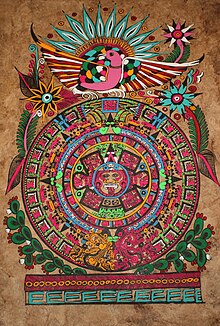
The Aztec Sun Stone as an amate print.
The Sun Stone of the Aztec civilization was once believed to be their equivalent of a Tzolk'in calendar, but is now thought to be a ceremonial representation of the entire universe as seen by the Aztec religious class.
The earliest interpretations of the stone relate to its use as a calendar. In 1792, two years after the stone's unearthing, Mexican anthropologist Antonio de León y Gama wrote a treatise on the Aztec calendar using the stone as its basis.[26] Some of the circles of glyphs are the glyphs for the days of the month.[27] The four symbols included in the Ollin glyph represent the four past suns that the Mexica believed the earth had passed through.[28]
Another aspect of the stone is its religious significance. One theory is that the face at the center of the stone represents Tonatiuh, the Aztec deity of the sun. It is for this reason that the stone became known as the "Sun Stone." Richard Townsend proposed a different theory, claiming that the figure at the center of the stone represents Tlaltecuhtli, the Mexica earth deity who features in Mexica creation myths.[27] Modern archaeologists, such as those at the National Anthropology Museum in Mexico City, believe it is more likely to have been used primarily as a ceremonial basin or ritual altar for gladiatorial sacrifices than as an astrological or astronomical reference.[29]
Yet another characteristic of the stone is its possible geographic significance. The four points may relate to the four corners of the earth or the cardinal points. The inner circles may express space as well as time.[30]
Lastly, there is the political aspect of the stone. It may have been intended to show Tenochtitlan as the center of the world and therefore, as the center of authority.[31] Townsend argues for this idea, claiming that the small glyphs of additional dates amongst the four previous suns—1 Flint (Tecpatl), 1 Rain (Atl), and 7 Monkey (Ozomahtli)—represent matters of historical importance to the Mexica state. He posits, for example, that 7 Monkey represents the significant day for the cult of a community within Tenochtitlan. His claim is further supported by the presence of Mexica ruler Moctezuma II's name on the work. These elements ground the Stone's iconography in history rather than myth and the legitimacy of the state in the cosmos.[32]
Christianity

The round window at the site of the Marsh Chapel Experiment supervised by Walter Pahnke
Forms which are evocative of mandalas are prevalent in Christianity: the celtic cross; the rosary; the halo; the aureole; oculi; the Crown of Thorns; rose windows; the Rosy Cross; and the dromenon on the floor of Chartres Cathedral. The dromenon represents a journey from the outer world to the inner sacred centre where the Divine is found.[33]
The Cosmati pavements, including that at Westminster Abbey, are geometric mandala-like mosaic designs from thirteenth century Italy. The Great Pavement at Westminster Abbey is believed to embody divine and cosmic geometries as the seat of enthronement of the monarchs of England.[34]
Similarly, many of the Illuminations of Hildegard von Bingen can be used as mandalas, as well as many of the images of esoteric Christianity, as in Christian Hermeticism, Christian Alchemy, and Rosicrucianism.
Alchemist, Mathematician and Astrologer John Dee developed a geometric symbol which he called the Sigillum Dei 'Seal of God' manifesting a universal geometric order which incorporated the names of the archangels, derived from earlier forms of the clavicula salomonis or key of Solomon.

The Seal of God; a mystic pentagram symbol composed by Dee
The Layer Monument, an early 17th-century marble mural funerary monument at the Church of Saint John the Baptist, Maddermarket, Norwich, is a rare example of Christian iconography absorbing alchemical symbolism to create a mandala in Western funerary art.
Mandalas in Persian art
In Persian Islamic theosophy, each of us is a part of God. We have been separated from our source like the rays of the sun and, we need to always keep in our mind that we have a divine light in us, which is the source of love. This light always shows us the right path to grow and find our way back to our source.
Therefore, in Persian Shamseh motif which symbolizes the sun, there is a center which is the symbol of god or the source of energy. This small circle is surrounded by many other circles or polygons with the same center but in different sizes. These circles are the light rays of the sun which symbolize every god's creature. Every creature tends to reach God, so the purpose of life is to reach back the source of energy which is mentioned as pure love in some references. Some of us are closer to our origin, while some of us have a long journey to reach it. As in Shamseh, some circles are smaller, therefore, closer to the center.
Shamseh motif was wildly applied during Safavid time in Iran. Safavid was one of the most important ruling dynasties of Iran in art, architecture, astrology, philosophy, and theosophy. An extraordinary example of Shamseh motif would be the tiling of the ceiling of Sheik Lotfollah mosque in Isfahan. Persian "Shamseh" motif painted on a copper plate. The art of hand painting and enameling is called "Meenakari" in Farsi.
Western psychological interpretations
According to art therapist and mental health counselor Susanne F. Fincher, we owe the re-introduction of mandalas into modern Western thought to Carl Jung, the Swiss analytical psychologist. In his pioneering exploration of the unconscious through his own art making, Jung observed the motif of the circle spontaneously appearing. The circle drawings reflected his inner state at that moment. Familiarity with the philosophical writings of India prompted Jung to adopt the word "mandala" to describe these circle drawings he and his patients made. In his autobiography, Jung wrote:
I sketched every morning in a notebook a small circular drawing, ... which seemed to correspond to my inner situation at the time. ... Only gradually did I discover what the mandala really is: ... the Self, the wholeness of the personality, which if all goes well is harmonious.
— Carl Jung, Memories, Dreams, Reflections, pp. 195–196.
Jung recognized that the urge to make mandalas emerges during moments of intense personal growth. Their appearance indicates a profound re-balancing process is underway in the psyche. The result of the process is a more complex and better integrated personality.
The mandala serves a conservative purpose—namely, to restore a previously existing order. But it also serves the creative purpose of giving expression and form to something that does not yet exist, something new and unique. ... The process is that of the ascending spiral, which grows upward while simultaneously returning again and again to the same point.
— Jungian analyst Marie-Louise von Franz, C. G. Jung: Man and His Symbols, p. 225
Creating mandalas helps stabilize, integrate, and re-order inner life.[35]
According to the psychologist David Fontana, its symbolic nature can help one "to access progressively deeper levels of the unconscious, ultimately assisting the meditator to experience a mystical sense of oneness with the ultimate unity from which the cosmos in all its manifold forms arises."[36]
In archaeology
One of the most intense archaeological discoveries in recent years that could redefine the history of eastern thought and tradition of mandala is the discovery of five giant mandalas in the valley of Manipur made with Google Earth imagery. Located in the paddy field in the west of Imphal, the capital of Manipur, the Maklang geoglyph is perhaps the world's largest mandala built entirely of mud. The site wasn’t discovered until 2013 as its whole structure could only be visible via Google Earth satellite imagery. The whole paddy field, locally known as Bihu Loukon, is now protected and announced as historical monument and site by the government of Manipur in the same year. The site is situated 12 km aerial distance from Kangla with the GPS coordinates of 24° 48' N and 93° 49' E. It covers a total area of around 224,161.45 square meters. This square mandala has four similar protruding rectangular ‘gates’ in the cardinal directions guarded each by similar but smaller rectangular ‘gates’ on the left and right. Within the square there is an eight petalled flower or rayed-star, recently called as Maklang ‘Star fort’ by the locals, in the centre covering a total area of around 50,836.66 square meters. The discovery of other five giant mandalas in the valley of Manipur is also made with Google Earth. The five giant mandalas, viz., Sekmai mandala, Heikakmapal mandala, Phurju twin mandalas and Sangolmang mandala are located on the western bank of the Iril River.[37]
In architecture
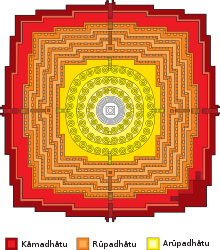
Borobudur ground plan taking the form of a Mandala
Buddhist architecture often applied mandala as the blueprint or plan to design Buddhist structures, including temple complex and stupas. A notable example of mandala in architecture is the 9th century Borobudur in Central Java, Indonesia. It is built as a large stupa surrounded by smaller ones arranged on terraces formed as a stepped pyramid, and when viewed from above, takes the form of a giant tantric Buddhist mandala, simultaneously representing the Buddhist cosmology and the nature of mind.[38] Other temples from the same period that also have mandala plans include Sewu, Plaosan and Prambanan. The similar mandala plan design are also observable in Cambodia, Thailand and Myanmar.
In science
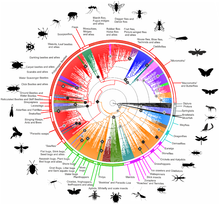
Phylogenetic tree of Hexapoda (insects and their six-legged relatives). Such trees have been called phylogenetic mandalas.[39]
Circular diagrams are often used in phylogenetics, especially for the graphical representation of phylogenetic relationships. Evolutionary trees often encompass numerous species that are conveniently shown on a circular tree, with images of the species shown on the periphery of a tree. Such diagrams have been called phylogenetic mandalas.[39]
In contemporary use
Mandalas can be found in early Buddhist art from the 14th and 15th centuries.
Fashion designer Mandali Mendrilla designed an interactive art installation called Mandala of Desires (Blue Lotus Wish Tree) made in peace silk and eco friendly textile ink, displayed at the China Art Museum in Shanghai in November 2015. The pattern of the dress was based on the Goloka Yantra mandala, shaped as a lotus with eight petals. Visitors were invited to place a wish on the sculpture dress, which will be taken to India and offered to a genuine living Wish Tree.[40][41]
Gallery

Cosmological mandala with Mount Meru, silk tapestry, China via The Metropolitan Museum of Art

Vajrabhairava mandala, silk tapestry, China via The Metropolitan Museum of Art
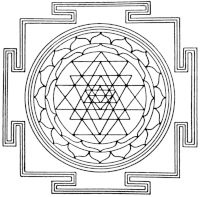
A diagramic drawing of the Sri Yantra, showing the outside square, with four T-shaped gates, and the central circle
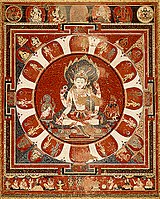
Vishnu Mandala(Traditionally found in Nepal)

Painted 19th century Tibetan mandala of the Naropa tradition, Vajrayogini stands in the center of two crossed red triangles, Rubin Museum of Art

Painted Bhutanese Medicine Buddha mandala with the goddess Prajnaparamita in center, 19th century, Rubin Museum of Art
Mandala of the Six Chakravartins

Vajravarahi mandala

Kalachakra mandala

Jain cosmological diagrams and text.
Mandala painted by a patient of Carl Jung
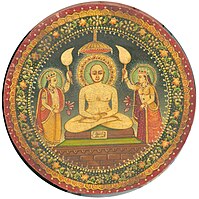
Jain picture of Mahavira
See also
- Architectural drawing
- Astrological symbols
Bhavacakra – A symbolic representation of cyclic existence- Chakra
Dharmachakra – One of the Ashtamangala of Indian religions such as Jainism, Buddhism, and Hinduism- Form constant
- Ganachakra
- Great chain of being
- Vitalism
- Magic Circle
Mandylion, the first icon in Christianity- Namkha
- Religious art
- Sri Yantra
- Yantra
References
^ "mandala". Merriam–Webster Online Dictionary. 2008. Retrieved 2008-11-19..mw-parser-output cite.citation{font-style:inherit}.mw-parser-output .citation q{quotes:"""""""'""'"}.mw-parser-output .citation .cs1-lock-free a{background:url("//upload.wikimedia.org/wikipedia/commons/thumb/6/65/Lock-green.svg/9px-Lock-green.svg.png")no-repeat;background-position:right .1em center}.mw-parser-output .citation .cs1-lock-limited a,.mw-parser-output .citation .cs1-lock-registration a{background:url("//upload.wikimedia.org/wikipedia/commons/thumb/d/d6/Lock-gray-alt-2.svg/9px-Lock-gray-alt-2.svg.png")no-repeat;background-position:right .1em center}.mw-parser-output .citation .cs1-lock-subscription a{background:url("//upload.wikimedia.org/wikipedia/commons/thumb/a/aa/Lock-red-alt-2.svg/9px-Lock-red-alt-2.svg.png")no-repeat;background-position:right .1em center}.mw-parser-output .cs1-subscription,.mw-parser-output .cs1-registration{color:#555}.mw-parser-output .cs1-subscription span,.mw-parser-output .cs1-registration span{border-bottom:1px dotted;cursor:help}.mw-parser-output .cs1-ws-icon a{background:url("//upload.wikimedia.org/wikipedia/commons/thumb/4/4c/Wikisource-logo.svg/12px-Wikisource-logo.svg.png")no-repeat;background-position:right .1em center}.mw-parser-output code.cs1-code{color:inherit;background:inherit;border:inherit;padding:inherit}.mw-parser-output .cs1-hidden-error{display:none;font-size:100%}.mw-parser-output .cs1-visible-error{font-size:100%}.mw-parser-output .cs1-maint{display:none;color:#33aa33;margin-left:0.3em}.mw-parser-output .cs1-subscription,.mw-parser-output .cs1-registration,.mw-parser-output .cs1-format{font-size:95%}.mw-parser-output .cs1-kern-left,.mw-parser-output .cs1-kern-wl-left{padding-left:0.2em}.mw-parser-output .cs1-kern-right,.mw-parser-output .cs1-kern-wl-right{padding-right:0.2em}
^ Kheper,The Buddhist Mandala – Sacred Geometry and Art
^ www.sbctc.edu (adapted). "Module 4: The Artistic Principles" (PDF). Saylor.org. Retrieved 2 April 2012.
^ Khanna Madhu, Yantra: The Tantric Symbol of Cosmic Unity. Thames and Hudson, 1979, p. 12.
^ Khanna, Madhu, Yantra: The Tantric Symbol of Cosmic Unity. Thames and Hudson, 1979, pp. 12-22
^ Singh, Prof. Mahendra Prasad (2011). Indian Political Thought: Themes and Thinkers. Pearson Education India.
ISBN 8131758516. pp. 11-13.
^ Dellios, Rosita (2003-01-01). "Mandala: from sacred origins to sovereign affairs in traditional Southeast Asia". Bond University Australia. Retrieved 2011-12-11.
^ John Ankerberg, John Weldon, Encyclopedia of New Age Beliefs: The New Age Movement, p. 343
^ "Vajrabhairava Mandala". The Metropolitan Museum of Art. The Metropolitan Museum of Art. Retrieved 19 November 2017.
^ Watt, James C.Y. (1997). When Silk was Gold: Central Asian and Chinese Textiles. New York: The Metropolitan Museum of Art. p. 95.
^ Mipham (2000) pp. 65,80
^ "Cosmological Mandala with Mount Meru". The Metropolitan Museum of Art. The Metropolitan Museum of Art. Retrieved 19 November 2017.
^ Watt, James C.Y. (2010). The World of Khubilai Khan: Chinese Art in the Yuan Dynasty. New York: Yale University Press. p. 247. Retrieved 19 November 2017.
^ "A Monograph on a Vajrayogini Thanka Painting". 13 August 2003. Archived from the original on 13 August 2003.CS1 maint: BOT: original-url status unknown (link)
^ Camphausen, Rufus C. "Charnel- and Cremation Grounds". Retrieved 10 October 2016.
^ "Archived copy". Archived from the original on 2006-03-03. Retrieved 2006-11-25.CS1 maint: Archived copy as title (link)
^ ab "Mandala". Retrieved 10 October 2016.
^ "The Mandala in Tibet". Retrieved 10 October 2016.
^ "Mandala". Retrieved 10 October 2016.
^ Per Kvaerne 1975: p. 164
^ Kvaerne, Per (1975). "On the Concept of Sahaja in Indian Buddhist Tantric Literature. (NB: article first published in Temenos XI (1975): pp.88-135). Cited in: Williams, Jane (2005). Buddhism: Critical Concepts in Religious Studies, Volume 6. Routledge. ISBN 0-415-33226-5, ISBN 978-0-415-33226-2". Retrieved April 16, 2010.
^ "What Is a Mandala?". studybuddhism.com.
^ "Preliminary practice (ngöndro) overview". Retrieved 10 October 2016.
^ Frontiers of Anthropology — The Mayan Mandala
^ Mandalas of the Maya: Celestial Waters and the Auroral Plumes of Tláloc
^ Antonio de León y Gama: Descripción histórica y cronológica de las dos piedras León y Gama
^ ab K. Mills, W. B. Taylor & S. L. Graham (eds), Colonial Latin America: A Documentary History, 'The Aztec Stone of the Five Eras', p. 23
^ Townsend, Casey (1979). State and Cosmos in the Art of Tenochtitlan. Washington, DC: Dumbarton Oaks.
^ Getty Museum, "Aztec Calendar Stone" getty.edu, accessed 22 August 2018
^ K. Mills, W. B. Taylor & S. L. Graham (eds), Colonial Latin America: A Documentary History, 'The Aztec Stone of the Five Eras', pp. 23, 25
^ K. Mills, W. B. Taylor & S. L. Graham (eds), Colonial Latin America: A Documentary History, 'The Aztec Stone of the Five Eras', pp. 25-6
^ Townsend, Richard Fraser (1997-01-01). State and cosmos in the art of Tenochtitlan. Dumbarton Oaks, Trustees for Harvard University. ISBN 9780884020837. OCLC 912811300.
^ See David Fontana: "Meditating with Mandalas", p. 11, 54, 118
^ "Cosmati Pavement - Video Library". www.westminster-abbey.org.
^ see Susanne F. Fincher: Creating Mandalas: For Insight, Healing, and Self-Expression, pp. 1 - 18
^ See David Fontana: Meditating with Mandalas, p. 10
^ Wangam, Somorjit (2018). World's Largest Mandalas from Manipur and Carl Jung's Archetype of the Self, p. 25-33. NeScholar, ed. Dr. R.K.Nimai Singh ,Imphal.
ISSN 2350-0336.
^ A. Wayman (1981). "Reflections on the Theory of Barabudur as a Mandala". Barabudur History and Significance of a Buddhist Monument. Berkeley: Asian Humanities Press.
^ ab Hasegawa, Masami (2017). "Phylogeny mandalas for illustrating the Tree of Life". Molecular Phylogenetics and Evolution. 117: 168–178. doi:10.1016/j.ympev.2016.11.001. PMID 27816710.
^ "China Art Museum in Shanghai - Forms of Devotion". Retrieved 10 October 2016.
^ "Haljinu "Mandala of Desires" dnevno posjećuje čak 30 000 ljudi!".
Sources
.mw-parser-output .refbegin{font-size:90%;margin-bottom:0.5em}.mw-parser-output .refbegin-hanging-indents>ul{list-style-type:none;margin-left:0}.mw-parser-output .refbegin-hanging-indents>ul>li,.mw-parser-output .refbegin-hanging-indents>dl>dd{margin-left:0;padding-left:3.2em;text-indent:-3.2em;list-style:none}.mw-parser-output .refbegin-100{font-size:100%}
- Brauen, M. (1997). The Mandala, Sacred circle in Tibetan Buddhism Serindia Press, London.
- Bucknell, Roderick & Stuart-Fox, Martin (1986). The Twilight Language: Explorations in Buddhist Meditation and Symbolism. Curzon Press: London.
ISBN 0-312-82540-4
Cammann, S. (1950). Suggested Origin of the Tibetan Mandala Paintings The Art Quarterly, Vol. 8, Detroit.- Cowen, Painton (2005). The Rose Window, London and New York, (offers the most complete overview of the evolution and meaning of the form, accompanied by hundreds of colour illustrations.)
- Crossman, Sylvie and Barou, Jean-Pierre (1995). Tibetan Mandala, Art & Practice The Wheel of Time, Konecky and Konecky.
- Fontana, David (2005). "Meditating with Mandalas", Duncan Baird Publishers, London.
Gold, Peter (1994). Navajo & Tibetan sacred wisdom: the circle of the spirit. ISBN 0-89281-411-X. Rochester, Vermont: Inner Traditions International.- Mipham, Sakyong Jamgön (2002) 2000 Seminary Transcripts Book 1 Vajradhatu Publications
ISBN 1-55055-002-0
- Somorjit, Wangam (2018). "World's Largest Mandalas from Manipur and Carl Jung's Archetype of the Self", neScholar, vol.04, Issue 01, ed.Dr. R.K. Nimai Singh
ISSN 2350-0336
- Tucci, Giuseppe (1973). The Theory and Practice of the Mandala trans. Alan Houghton Brodrick, New York, Samuel Weisner.
- Vitali, Roberto (1990). Early Temples of Central Tibet London, Serindia Publications.
- Wayman, Alex (1973). "Symbolism of the Mandala Palace" in The Buddhist Tantras Delhi, Motilal Banarsidass.
Further reading
- Grotenhuis, Elizabeth Ten (1999). Japanese mandalas: representations of sacred geography, Honolulu: University of Hawai'i Press
External links
This article's use of external links may not follow Wikipedia's policies or guidelines. (October 2016) (Learn how and when to remove this template message) |
| Wikimedia Commons has media related to Mandalas. |
- Introduction to Mandalas
- Mandalas in the Tradition of the Dalai Lamas' Namgyal Monastery by Losang Samten
Kossak, S (1998). Sacred visions : early paintings from central Tibet. New York: The Metropolitan Museum of Art. (see index)
gd93y2OnxIxPvvvgkA tv7SWz3R jXba9 4QSkSrUo3FR IM TgyA,YxjX xFjX,EmKAp,bCFAFgUBV 1cI0z3U MmXF,ppAR,WTwVT61vjG






